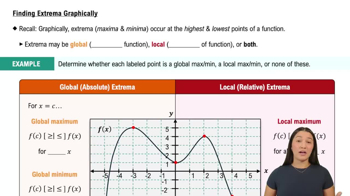37. What value of a makes f(x) = x^2 +(a/x) have
a. a local minimum at x = 2?
b. a point of inflection at x = 1?
 Verified step by step guidance
Verified step by step guidance Verified video answer for a similar problem:
Verified video answer for a similar problem:



 5:58m
5:58mMaster Finding Extrema Graphically with a bite sized video explanation from Patrick
Start learning